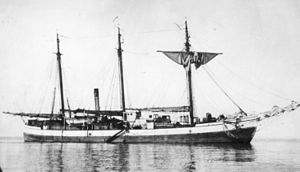 CGS Arctic at anchor at Pond Inlet in 1923 CGS Arctic at anchor at Pond Inlet in 1923
| |
| History | |
|---|---|
| Name | Gauss |
| Namesake | Carl Friedrich Gauss |
| Builder | Howaldtswerke-Deutsche Werft, Kiel |
| Cost | 500,000 marks |
| Launched | 2 April 1901 |
| In service | 1901 |
| Out of service | 1903 |
| Fate | Sold to Canada, 1904 |
| Name | Arctic |
| Acquired | by purchase, 1904 |
| In service | 1904 |
| Out of service | 1925 |
| Fate | Abandoned, 1925 |
| General characteristics | |
| Type | Polar exploration vessel |
| Tonnage | 762 GRT |
| Displacement | 1,442 long tons (1,465 t) |
| Length | 46 m (150 ft 11 in) |
| Beam | 11 m (36 ft 1 in) |
| Draught | 4.8 m (15 ft 9 in) |
| Ice class | A1 |
| Propulsion | 1 × 325 hp (242 kW) auxiliary triple expansion steam engine, single screw |
| Sail plan |
|
| Speed | 7 knots (13 km/h; 8.1 mph) |
| Capacity | 700 tons of stores |
| Crew | 30 |
Gauss was a ship built in Germany for polar exploration, named after the mathematician and physical scientist Carl Friedrich Gauss. Purchased by Canada in 1904, the vessel was renamed CGS Arctic. As Arctic, the vessel made annual trips to the Canadian Arctic until 1925. The ship's fate is disputed among the sources, but all claim that by the mid-1920s, the vessel was out of service.
Ship construction
The ship was built by the Howaldtswerke-Deutsche Werft shipyard at Kiel at a cost of 500,000 marks. Launched on 2 April 1901 she was modelled on Fridtjof Nansen's ship Fram, and rigged as a barquentine. Displacing 1,442 long tons (1,465 t), Gauss had a tonnage of 762 gross register tons (GRT). The ship was 46 m (150 ft 11 in) long, 11 m (36 ft 1 in) in the beam, with a draught of 4.8 m (15 ft 9 in). With a 325 hp (242 kW) triple expansion steam engine driving one screw to augment the sails, she was capable of 7 knots (13 km/h; 8.1 mph).
Classed "A1" by Germanischer Lloyds, she was designed to carry 700 tons of stores, enough to make her self-sufficient for up to three years with a crew of 30 aboard. The hull was robust, and the rudder and propeller were designed to be hoisted aboard for inspection or repairs.
Ship history

Between 1901 and 1903 Gauss explored the Antarctic in the Gauss expedition under the leadership of Erich von Drygalski.
In early 1904, the Canadian government purchased the ship under the advice of Joseph-Elzéar Bernier, who surveyed the ship before the acquisition. The ship was renamed Arctic and under the command of Bernier she explored the Arctic Archipelago. Bernier and Arctic made annual expeditions to Canada's north. On 1 July 1909, Bernier, without government approval, claimed the entire area between Canada's eastern and western borders all the way to the North Pole. Bernier only left the ship during the First World War, returning to command Arctic again from 1922 to 1925. The vessel's end is not agreed upon. According to schiffe-und-mehr.com, Arctic was abandoned in 1925 and left to rot at her moorings. Maginley and Collin claim the vessel was broken up in 1926 while the Miramar Ship Index say the ship was abandoned in 1927.
See also
Notes
- The Miramar Ship Index and Maginley and Collin have the ship's length between perpendiculars as 50.4 m (165.4 ft) and its beam as 11.3 m (37.1 ft).
- Maginley and Collin have the vessel's engine rated at 44 hp (33 kW) (nominal).
References
- ^ "Expeditionsschiff (Barkentine) Gauss". schiffe-und-mehr.com (in German). 2012. Archived from the original on 18 July 2024. Retrieved 3 August 2012.
- ^ Appleton, Thomas E. (2012). "Usque Ad Mare – The Last Phase of Wooden Shipbuilding". Canadian Coast Guard. Retrieved 3 August 2012.
- ^ "German National Antarctic Expedition 1901–03". coolantarctica.com. 2012. Archived from the original on 28 May 2012. Retrieved 3 August 2012.
- Mill, Hugh Robert (1905). "Chapter XX: Early Expeditions of the Twentieth Century". The Siege Of The South Pole: The Story of Antarctic Exploration. Archived from the original on 30 November 2024. Retrieved 3 August 2012.
- Stephenson, Robert B. (2010). "Antarctic Ship". antarctic-circle.org. Archived from the original on 3 December 2024. Retrieved 3 August 2012.
- ^ "Gauss (1116992)". Miramar Ship Index. Retrieved 27 May 2017.
- ^ Maginley, Charles D.; Collin, Bernard (2001). The Ships of Canada's Marine Services. St. Catharines, Ontario: Vanwell Publishing Limited. p. 30. ISBN 1-55125-070-5.
- MacEachern, Alan (2010). "J.E. Bernier's Claims to Fame" (PDF). Scientia Canadensis: Canadian Journal of the History of Science, Technology and Medicine. 33 (2). Ottawa: Canadian Science and Technology Historical Association: 43–73. doi:10.7202/1006150ar. ISSN 0829-2507. Archived from the original (PDF) on 24 June 2019. Retrieved 3 August 2012.
Further reading
- Murphy, David Thomas (2002). "Imperial Failure in the Antarctic". German Exploration of the Polar World : A History, 1870–1940. Lincoln: University of Nebraska Press. pp. 65–106. ISBN 0-8032-3205-5.
External links
- W.B. Wiegand Diary of a Voyage on the Arctic in 1912 at Dartmouth College Library